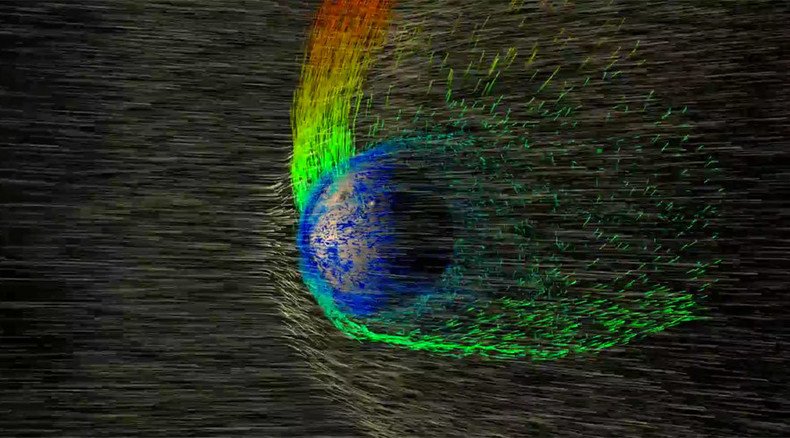Warm & wet Mars stripped of atmosphere by solar winds – NASA

Mars was once warm and wet, but has had its atmosphere stripped away by solar winds over billions of years, NASA revealed. The announcement is the latest in a series of new findings about the surface of the Red Planet.
NASA’s Mars Atmosphere and Volatile Evolution (MAVEN) spacecraft began orbiting Mars for the purpose of examining its atmosphere in unprecedented detail.
The scientists revealed the latest findings of MAVEN during a Thursday press conference, saying that solar winds created climate change at the red planet leading to "the erosion of Mars’ atmosphere."
#MAVEN Reveals Speed of Solar Wind Stripping Mars' Atmosphere https://t.co/ikxwCaxz2g VIDEO: https://t.co/TZfqX29S80pic.twitter.com/i0ggJc4lhM
— NASA's MAVEN Mission (@MAVEN2Mars) November 5, 2015MAVEN has been orbiting Mars since 2014, and it was designed to understand the changes in climate, according to Bruce Jakosky, MAVEN Principal Investigator.
While today's Mars is a cold, dry desert-like environment incapable of sustaining water, ancient Mars had valleys that could have been carved by water, long-standing lakes and a climate that must have been warmer and wetter, with a thicker atmosphere, Jakosky noted.
Unlike Earth, Mars does not have a magnetic field to shield its atmosphere from solar wind: https://t.co/gUTToNj6dVhttps://t.co/aHobWVmsgo
— NASA (@NASA) November 5, 2015“Mars lost its atmosphere. It could have been frozen out. It could have been turned into rocks, could have been knocked out by meteors, could have been stripped from the planet by solar wind. To answer, NASA sent the MAVEN mission to Mars,” NASA's Mars Exploration Program lead scientist Michael Meyer said.
“I'll quote Bob Dylan: The answer my friend, is blowing in the wind."
The difference between Earth and Mars, the scientists note, is that that the Earth is protected from million-mile-an-hour solar winds that is bombarding it, preventing its atmosphere from being stripped away. Much of the matter being stripped away is carbon and oxygen, which are important atmospheric elements to have for water.
Mars, lacking a core of the same heat and composition as ours, doesn't have such a luxury. Ions from the upper atmosphere are grabbed by the solar particles, which then escape into space.
"Earth has a strong magnetic field that shields atmosphere from global wind. Its upper atmosphere can be stripped away into portions of space. Mars does not have such a large magnetic shield. Its atmosphere is small, but enough to protect surface from solar wind, deflecting it away," said Jasper Halekas, MAVEN Solar Wind Ion Analyzer instrument lead at the University of Iowa, Iowa City.
What does penetrate Earth's powerful magnetic field results in aurora borealis, better known as the Northern Lights. That's because the poles of our planet is where the magnetic protection is at our weakness, and we see the solar wind that passes through as a brilliant display of glowing colors. Because Mars has a weak magnetic field all over the planet, that means that it gets auroras too.
Scientists estimate that Mars had an abundance of active, flowing water and a thick atmosphere up until at one point. All of that changed when Mars' once-Earthlike magnetic field greatly weakened around 4.2 billion years ago, leaving it vulnerable to the era's particularly intense solar activity.
It was between that time and 3.7 billion years ago Mars transformed into the red barren planet that we know today. The loss of atmosphere is much slower today, but it still occurs at a rate of about a quarter pound of atoms – about as much as a hamburger – every second.
An earlier heavy-hitting announcement occurred in late September, when the space agency revealed that Mars almost certainly has flowing, liquid water on its surface. There are also suspicions that there may be underground aquifers on the Red Planet.












